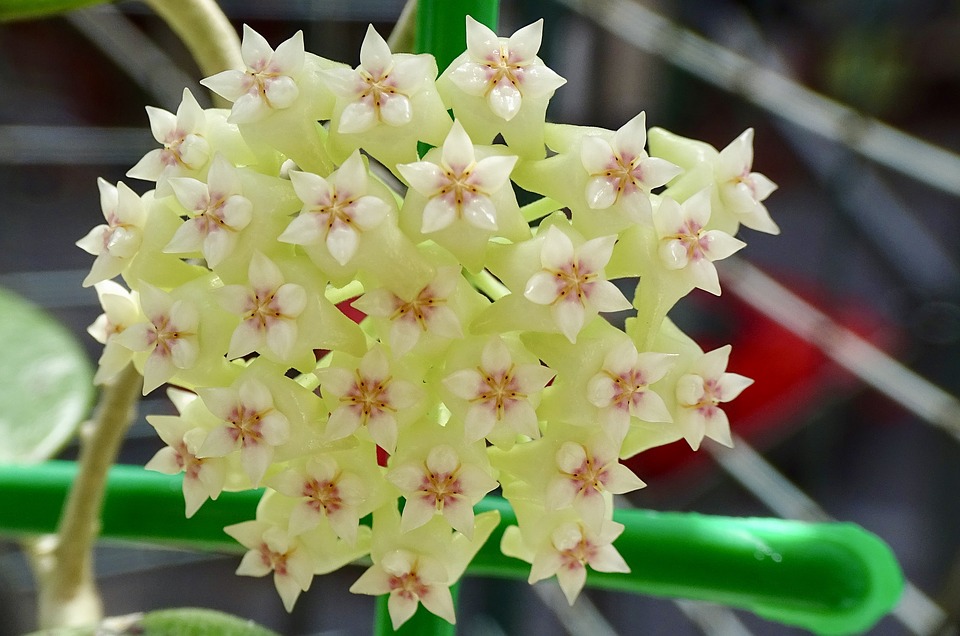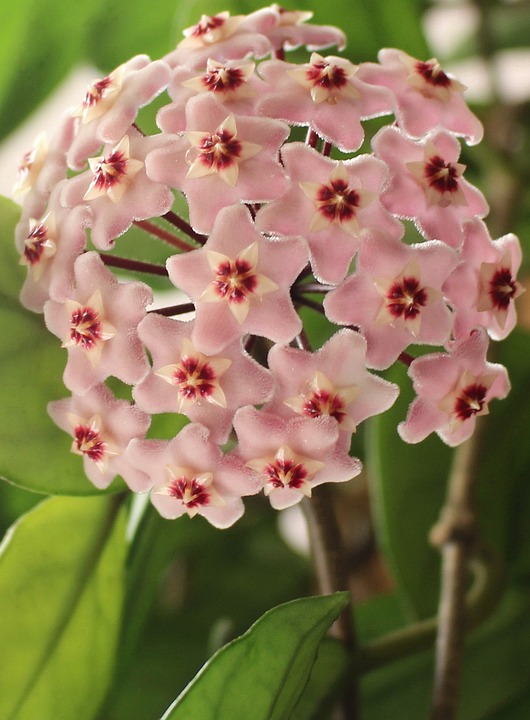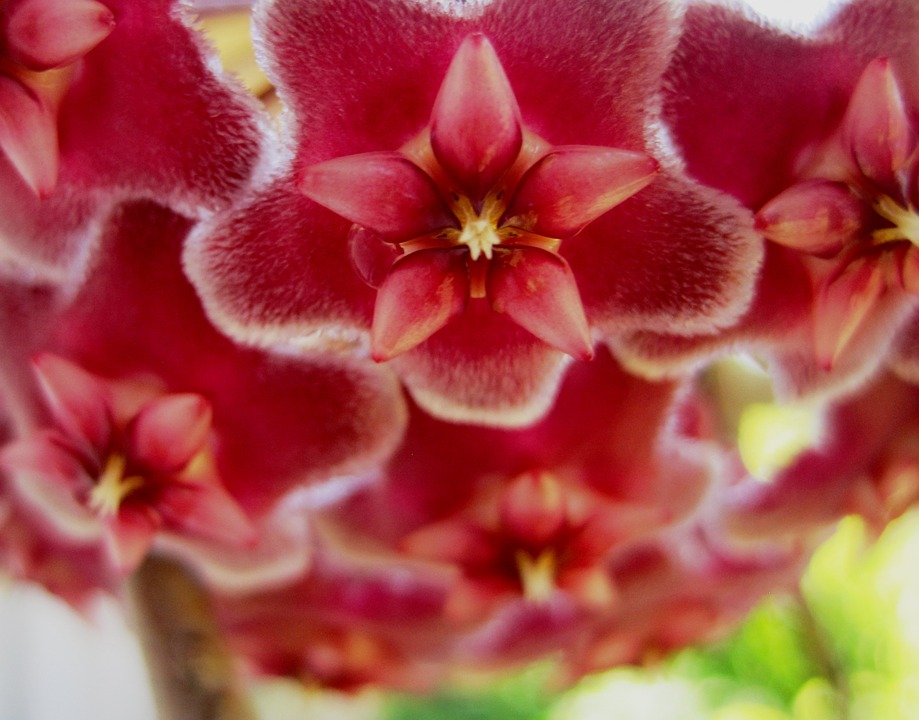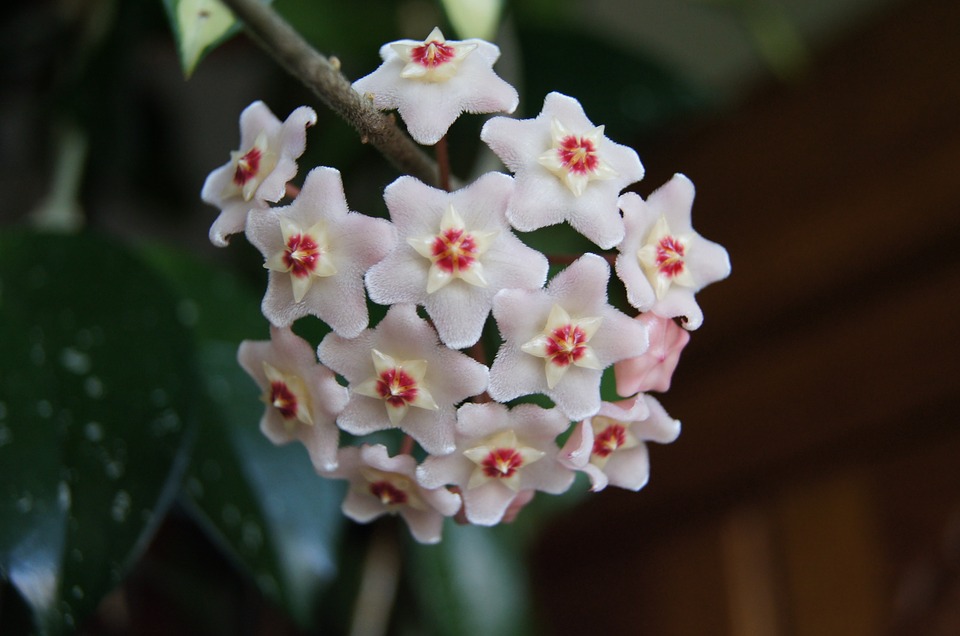Hoya Tricolor - how to properly care for abundant flowering
Hoya ... There is a Japanese exotic in this name, consonant with hokku, hikaru, hoi. And yet this is the “correct” name for the wax flowers so popular with our grandmothers. The flower has again become in demand in home floriculture. And this is deserved - a minimum of care, a maximum of decorativeness, especially in such piquant varieties as Hoya Tricolor. And feng shui is quite supportive of this plant.

Hoya tricolor bloom
Family Brief
Hoyi (Hóya) are evergreen natives of the tropics: sparse forests of subtropical and tropical Asia, Central America, Polynesia, Australia. The genus was first described in 1810. By 2015, about 700 descriptions of hoi were included in the catalog for decorative floriculture.
The family received an exotic name in honor of a gardener from England, Thomas Hoy (1750 - 1822), known for his collections of greenhouse plants.
Terrestrial shrubs and lianas up to 10 m long, succulents and epiphytes - the appearance of representatives of this family is very different.
Hoyi combines 2 characteristic features:
- "Waxy" leaves;
- beautiful "porcelain" star-shaped flowers with a strong pleasant aroma.
Description of the variety
One of the most common types of Hoya is hoya carnosa. Thick, tough leaves appear to be covered with wax, hence the other names: hoya waxy or waxy ivy (although it belongs to vines and has nothing to do with ivy).
Some varieties are variegated (variegated). These include the Tricolor variety (hoya tricolor). The leaves, initially white-pink, gradually turn green at the edges, and the middle becomes yellow or reddish. Young shoots have a purple tint.
The flower shape is typical for hoya: a small five-pointed star. Each consists of two stars:
- lower - flesh-colored corolla (larger);
- the upper one is a bright red crown.
25-30 flowers are collected in bunches. Long bloom (about six months), starting in April. The aroma is strong, sweet.
In home floriculture, they are used both curly (in one long stem) and ampelous (in several shorter shoots).
Purchase and adaptation
When choosing a plant, you should pay attention to the turgor and shine of the leaves. In a diseased flower, they are lethargic and dull, with spots. If you buy a blooming hoya, then you need to inspect the inflorescences - the drops of nectar that appear on the petals attract various insects that should not be brought home.

Hoya tricolor home care
After purchase, the flower must acclimatize in a new place. To avoid the spread of possible infections, it is quarantined for 3-4 weeks and examined daily.
Landing rules
Hanging pots are often chosen for planting.
Hoya is an epiphyte, it needs air access to the roots. This is better provided by porous clay pots.
If the plant is planned to be grown as climbing, then it needs supports.
Tricolor vines can grow up to 4-5 m.
Selection of soil and location
Hoya does not like excessive moisture. The substrate for the plant should be light and breathable. For its preparation, expanded clay, peat, sphagnum, perlite, sand are used. If you plan to buy soil, then it is better to choose a soil mixture for succulents with the addition of coconut flakes. Drainage is required. It can be made from the same expanded clay.
The necessary conditions
Humidity
Room humidity should be moderate. Thanks to the dense thick leaves, the hoya can do without water for a long time. Water when the topsoil dries up. Excessive moisture provokes fungal diseases.

Hoya tricolor photo of flowering
Temperature
Hoya is a tropical evergreen. The optimum temperature for it is in the range from 15 ° С to 25 ° С. Moreover, the lower limit is permissible in winter in the absence of flowering.
Lighting
This should be a well-lit place, but without direct sunlight, from which burns appear on the plant. Window sills on the east or west side work best. In the shade of the Tricolor, variegation disappears, the leaves become a solid green color.
Care
Hoya is unpretentious, but it is advisable to observe conditions close to natural.

Hoya tricolor home care
Top dressing
Chloe Tricolor is a slow growing vine. During the season, two additional fertilizing with a mineral complex of the full composition of NPK (nitrogen, phosphorus, potassium) with a reduced nitrogen content (no more than 8%) is sufficient. Its excess provokes the emergence of soft loose leaves and long, "naked" stems. The proportion of potassium and phosphorus can start from 17%. If you plan to purchase ready-made dressings, then you should pay attention to fertilizers for epiphytic plants.
Watering
Hoya carnosa prefers rare but abundant watering.
The plant can be soaked in warm water for 1-2 hours while giving it a warm shower.
Such procedures are possible as long as the size of the flower allows. In this case, mineral nutrients are washed out of the substrate. This loss must be compensated for by subsequent feeding. In winter, during the dormant period, 1 monthly watering is enough for the plant. If the air is dry, the shoots can be additionally sprayed with warm water. In the spring, at the beginning of flowering, Tricolor is watered 2-3 times a month, as the topsoil dries up.
Transfer
The home vine needs a regular transplant. Young plants are transplanted annually, adults no more than once every 3-4 years. Better - in the spring, before flowering, using the transshipment method without disturbing the earthen coma.
The new pot should only be slightly larger than the old one. Otherwise, the hoya will begin to grow roots to the detriment of budding until it fills a new container with the root system.
Bloom
Hoya Tricolor is decorative at any time, thanks to the unusual color and shape of the leaves. But the flowering plant is truly admirable. If ideal conditions are created, especially in terms of lighting, then the flower can form buds the next year after rooting. More often - in the second or third year. Hoya in nature does not have a dormant period, it responds perfectly to artificial light.
If you provide the Tricolor with a 14-16 hour day with the help of phyto- or fluorescent lamps, it will delight you with abundant flowering year-round.
Breeding methods
Seeds
At home, hoya seeds are not tied, due to the lack of pollinating insects.

Hoya exotic tricolor
It is problematic to buy seeds in specialized stores. Purchasing over the Internet does not guarantee quality. Therefore, these vines are propagated vegetatively.
Cuttings
The most popular way. For this:
- a fragment with 2-3 pairs of leaves (8-10 cm) is cut off from the shoot of the previous year. Longer ones may dry out;
- the released juice is washed off with running water;
- the bottom pair of leaves is removed;
- rooted in water or solid substrate. In the latter case, moisture-absorbing perlite or vermiculite is well suited.
For reliability, several cuttings are germinated at once. To prevent them from drying out, a mini-greenhouse is built around them. After 2-3 weeks, roots will begin to sprout from a node in water or soil. After that, the sprout is transferred to a permanent place. Such a plant begins to bloom after about 4 years.
Layers
In this case, long shoots are pinned to the surface of the soil and sprinkled with a substrate and constantly moistened. This should be the node from which the leaves have been removed. After rooting, the cuttings are separated from the mother plant and planted separately. The advantage of this method is that the hoya can bloom next year.
Diseases and pests
Plant diseases can be caused by both pathogens and unfavorable conditions of maintenance and care.
| Diseases / pests | Signs of defeat | Treatment | Prophylaxis |
Fungal diseases:
| The roots soften and rot. The leaves turn yellow and wither. A gray or brown bloom appears. | Transplanting the plant into fresh soil. Fungicides. For the treatment of gray rot - 1% Bordeaux liquid | Compliance with the watering regime. Maintaining a comfortable temperature and light. |
| Bacterial diseases. | The leaves turn black. The stems dry out, and when pressed, a foul-smelling liquid is released. | Treatment with copper-containing preparations. | Treatment of the cut site with disinfectants. Use of a disinfected instrument. |
| Viral diseases | Light yellow or poor green spots appear on the leaves between or on the veins themselves, tubercles and thickenings are formed. | Difficult to treat. Destruction. | The main vectors are insect pests. Regular inspection of the plant, the introduction of quarantine for "newcomers". |
Insect pests:
| Cobwebs, pest nests, larvae and adults. | Insecticide treatment: Aktofit, Aktara, Confidor. | Regular examination, introduction of quarantine. Timely identification of the problem. |
Let hoya into your house! Just a little effort, knowledge of the basic rules of cultivation - and you will get an "eternal" spectacular plant, delighting for many, many years with extraordinary porcelain flowers and tricolor leaves. After all, is this what we want from pets?


